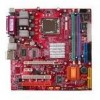MSI 915GM-FR User Manual - Page 52
ECP Mode Use DMA, PWRON After PWR-fail, IDE Devices Configuration, IDE HDD Block Mode, PCI IDE
 |
UPC - 816909006445
View all MSI 915GM-FR manuals
Add to My Manuals
Save this manual to your list of manuals |
Page 52 highlights
BIOS Setup ECP Mode Use DMA The ECP mode has to use the DMA channel, so choose the onboard parallel port with the ECP feature. After selecting it, the following message will appear: "ECP Mode Use DMA." At this time, the user can choose between DMA channel [3] or [1]. PWRON After PWR-fail This item specifies whether your system will reboot after a power failure or interrupt occurs. Available settings are: [Off] Leaves the computer in the power off state. [On] Leaves the computer in the power on state. [Former-sts] Restores the system to the status before power failure or interrupt occurred. IDE Devices Configuration Press and the following sub-menu appears: IDE HDD Block Mode Block mode is also called block transfer, multiple commands, or multiple sector read/write. If your IDE hard drive supports block mode (most new drives do), select [Enabled] for automatic detection of the optimal number of block read/ writes per sector the drive can support. Settings: [Enabled], [Disabled]. PCI IDE BusM aster Set this option to [Enabled] to specify that the IDE controller on the PCI local bus has bus mastering capability. Settings options: [Disabled], [Enabled]. On-Chip Primary PCI IDE The integrated peripheral controller contains an IDE interface with support for two IDE channels. Choose [Enabled] to activate each channel separately. Settings: [Enabled], [Disabled]. IDE Primary Master/Slave PIO The four IDE PIO (Programmed Input/Output) fields let you set a PIO mode (0-4) for each of the four IDE devices that the onboard IDE interface supports. Modes 0 through 4 provide successively increased performance. In [Auto] mode, the system automatically determines the best mode for each device. Setting options: [Auto], [Mode 0], [Mode 1], [Mode 2], [Mode 3], [Mode 4]. 3-17















